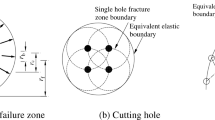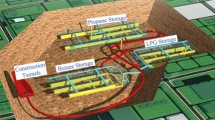Abstract
In order to ensure the safety of horseshoe-shaped pipeline during tunnel blasting excavation, the vibration test and dynamic response of horseshoe-shaped pipeline were investigated. The velocity and frequency of tunnel blasting vibration were analyzed. Sodev's empirical formula was used for regression analysis of the velocity of blasting vibration. 3D numerical model of a horseshoe-shaped pipelines was established with ALE algorithm using ANSYS/LS-DYNA. The propagation law of a blasting seismic wave was analyzed, and the transverse and longitudinal vibration response characteristics of pipelines under tunnel blasting vibration were studied. The velocity of the pipeline increases gradually and the frequency tends to decrease with the decrease of the distance away from the explosion source center under the same charge. The principal frequency of vibration in the Z direction is mainly distributed from 50 to 80 Hz, which is difficult to generate resonance with the pipelines. The maximum relative error between the simulated and measured velocity of X, Y and Z directions was 8.2%. It was reliable to study the dynamic response of pipelines under blasting vibration based on this numerical model. The blasting seismic wave first reached the bottom of the pipeline right above the explosive. Subsequently, seismic waves propagated along the transverse and the longitudinal axes of the pipeline, and the pressure on the pipeline increased gradually. And when it attenuated completely in the soil, the pipeline stopped its response. The peak value of tensile stress of each element of the vault is the largest. However, the velocity of the bottom plate and the arch roof of pipeline are the largest. The peak values of velocity and tensile stress exist in 0 to 4 m away from the explosion source, and gradually decrease as the distance away from the explosion source increases.












Similar content being viewed by others
References
De A, Morgante AN, Zimmie TF (2016) Numerical and physical modeling of geofoam barriers as protection against effects of surface blast on underground tunnels. Geotext Geomembr 44(1):1–12
Guan XM, Fu HX, Wang MS, Guo CX, Liu K, Liu TL (2017) Local dynamic response of a masonry structure to the vibrations of tunnel blasting. Mod Tunn Technol 54(3):135–141
Guan XM, Zhang L, Wang LM, Fu HX, Yu DM, Chen G, Ding Y, Jiang WL (2019) Blasting vibration characteristics and safety standard of pipeline passed down by tunnel in short distance. J Cent South Univ (Sci Technol) 50(11):2870–2885
Hallquist J (2015) LS-DYNA keyword user’s manual R8.0. Livermore Software Technology Corporation, California
Jayasinghe LB, Thambiratnam DP, Perera N, Jayasooriya JHAR (2013) Computer simulation of underground blast response of pile in saturated soil. Comput Struct 120:86–95
Jiang JJ, Lu XZ, Ye LP (2005) Finite element analysis of concrete structure. Tsinghua University Press, Beijing
Jiang N, Gao T, Zhou CB, Luo XD (2018) Effect of excavation blasting vibration on adjacent buried gas pipeline in a metro tunnel. Tunn Undergr Space Technol 81:590–601
Koneshwaran S (2014) Blast response and sensitivity analysis of segmental tunnel. Queensland University of Technology
Lewis BA (2004) Manual for LS-DYNA soil material model 147. Mathematical models
Li YC, Shi DY, Zhao Y (2008) Basic theory and engineering practice of ANSYS 110/LS-DYNA. China Water Power Press, Beijing
Li A, Liu Y, Dai F, Liu K, Wei MD (2020) Continuum analysis of the structurally controlled displacements for large-scale underground caverns in bedded rock masses. Tunn Undergr Space Technol 97:103288
Lin CM, Chen LB, Jiang LL, Zheng HL (2010) Research on blasting stability control technology of large-span highway tunnel with super-small clear spacing at highway expansion project. Chin J Rock Mech Eng 29(7):1371–1378
Liu HB (2012) Soil–structure interaction and failure of cast-iron subway tunnels subjected to medium internal blast loading. J Perform Constr Facil 26(5):691–701
Liu YP, Gong M, Huang GH (2012) Numerical analysis method for optimizing charging structure of deep-hole blasting and its application. Rock Soil Mech 33(6):1883–1888
Liu W, Liu J, Zhu C (2019) Multi-scale effect of acoustic emission characteristics of 3D rock damage. Arab J Geosci 12(22):668
Ma XF, Sui T, Shang JH, Wang DD (2011) Response analysis of dot shield tunnels under internal explosion. J Tongji Univ 39(7):983–988
Malvar LJ, Simons D (1996) Concrete material modeling in explicit computations. In: Workshop on recent advances in computational structural dynamics and high performance computing, USAE waterways experiment station, Vicksburg
Mane AS, Shete S, Bhuse A (2017) Effect of geofoam inclusion on deformation behavior of buried pipelines in cohesive soils. International congress and exhibition "sustainable civil infrastructures: innovative infrastructure geotechnology". Springer, Cham.
Mokhtari M, Nia AA (2015) A parametric study on the mechanical performance of buried X65 steel pipelines under subsurface detonation. Arch Civ Mech Eng 15(3):668–679
Mokhtari M, Nia AA (2016) The application of CFRP to strengthen buried steel pipelines against subsurface explosion. Soil Dyn Earthq Eng 87:52–62
Qin Z, Fu HL, Chen XX (2019) A study on altered granite meso-damage mechanisms due to water invasion-water loss cycles. Environ Earth Sci 78:428
Wu N, Liang ZZ, Zhou JR, Zhang YZ (2020) Energy evolution characteristics of coal specimens with preformed holes under uniaxial compression. Geomech Eng 20(1):55–66
Xu HL, Zhang JC, Guo JQ (2003) Investigation on formula of predicting the particle vibration velocity in drilling blasting. Blasting 20(3):75–78
Zhang XH, Duan ZD, Zhang CW (2009) Analysis for dynamic response and failure process of reinforced concrete beam under blast load. J Northeast For Univ 37(4):50–53
Zhang QS, Li LP, Li SC, Ding WT, Hong WL (2008) Experimental study of blasting dynamic vibration of closely adjacent tunnels. Rock Soil Mech 29(10):2655–2660
Zhang K, Zheng QP, Li SW, Hua WX (2013) Numerical simulation & analysis for impact of explosion under ground on buried pipelines. J Log Eng Univ 3:12–17
Zhang L, Liang Z, Zhang J (2016) Mechanical response of a buried pipeline to explosion loading. J Fail Anal Prev 16(4):576–582
Zhang LM, Zhao MS, Chi EA, Huang B, He XG (2017) Experiments for effect of blasting vibration on underground pipeline and risk prediction. J Vib Shock 36(16):241–247
Zhong DW, Huang X, Lu Z, Chen C, Si JF (2018) Experimental study on dynamic response of buried steel tubes with different sizes under blasting loading. Sci Technol Eng 18(13):219–223
Acknowledgements
This work is supported by the National Natural Science Foundation of China (Project No. 51708317), Key Research and Development Plan of Shandong Province (Project No. 2019GSF111027), the Taishan Scholar Priority Discipline Talent Group program funded by the Shan Dong Province, and first-class discipline project funded by the Education Department of Shandong Province (2019).
Author information
Authors and Affiliations
Corresponding author
Additional information
Publisher's Note
Springer Nature remains neutral with regard to jurisdictional claims in published maps and institutional affiliations.
Rights and permissions
About this article
Cite this article
Guan, X., Wang, X., Zhu, Z. et al. Ground Vibration Test and Dynamic Response of Horseshoe-shaped Pipeline During Tunnel Blasting Excavation in Pebbly Sandy Soil. Geotech Geol Eng 38, 3725–3736 (2020). https://doi.org/10.1007/s10706-020-01249-x
Received:
Accepted:
Published:
Issue Date:
DOI: https://doi.org/10.1007/s10706-020-01249-x




